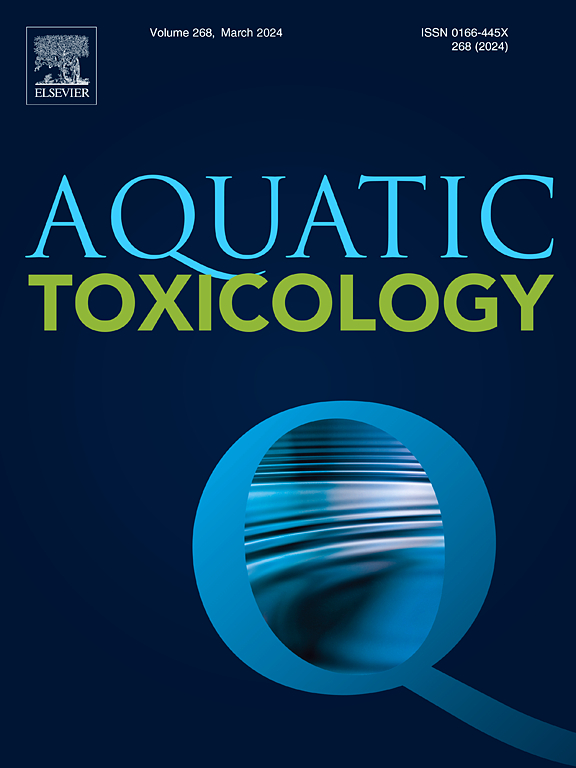Characterization of the marine medaka AHRs and the comparison with those of Japanese medaka in response to dioxin and additional AHR ligands
IF 4.1
2区 环境科学与生态学
Q1 MARINE & FRESHWATER BIOLOGY
引用次数: 0
Abstract
The global water pollution now calls for precise risk assessment of chemicals, e.g., dioxins and the dioxin-like compounds (DLCs). The freshwater and marine medaka have been widely implemented in the toxicity testing, and perhaps give mechanistic information for comparative biology. The question that ‘will they report equal results due to their close phylogenetic relation’ has been raised, therefore, we explored their physiological and molecular responses to dioxin. As the mediator of the dioxin toxicity, the aryl hydrocarbon receptor (AHR) of marine medaka (Oryzias melastigma) has not been functionally characterized and might be species-specific. In terms of sensitivity to dioxin—2,3,7,8-tetrachlorodibenzo-p-dioxin (TCDD), the EC50 values of omeAHR1a (0.16±0.12 nM), omeAHR1b (2.96±2.96 nM), omeAHR2a (0.44±0.30 nM), and omeAHR2b (9.00±6.88 nM) exhibit marked variations. The omeAHR2a and omeAHR1a display heightened sensitivity compared to the freshwater Japanese medaka (Oryzias latipes) counterparts olaAHR2a and olaAHR1a, respectively. The results indicate the in vitro sensitivity of AHR among species can vary by one or two orders of magnitude. Further mechanistic investigations using additional ligands and computational modeling reveal that: 1) most of omeAHR2a, olaAHR2a, dreAHR2, and hsaAHR interact with ligands in the affinity order of TCDD > PCB126 > BNF > indole, mirroring their AHR transactivation potency, but the docking poses and dynamics can vary; 2) one AHR subform's high sensitivity to dioxin—TCDD may extend to DLCs but not to other types of ligands. Beyond the in vitro study, the preliminary in vivo LC50 data indicate that marine medaka (LC50: 1.64 ng/L (95 % CI: 1.05–2.55 ng/L)) has similar sensitivity, and possibly slightly greater (not statistically determined yet), to TCDD in comparison with Japanese medaka (LC50: 3.42 ng/L (95 % CI: 1.37–6.48 ng/L)).These insights underscore the difference of AHR biology among species even the close relative species, and point out the necessity for meticulous consideration when evaluating the toxicity of compounds and when extending predictive toxicity assessments to more species.

求助全文
约1分钟内获得全文
求助全文
来源期刊

Aquatic Toxicology
环境科学-毒理学
CiteScore
7.10
自引率
4.40%
发文量
250
审稿时长
56 days
期刊介绍:
Aquatic Toxicology publishes significant contributions that increase the understanding of the impact of harmful substances (including natural and synthetic chemicals) on aquatic organisms and ecosystems.
Aquatic Toxicology considers both laboratory and field studies with a focus on marine/ freshwater environments. We strive to attract high quality original scientific papers, critical reviews and expert opinion papers in the following areas: Effects of harmful substances on molecular, cellular, sub-organismal, organismal, population, community, and ecosystem level; Toxic Mechanisms; Genetic disturbances, transgenerational effects, behavioral and adaptive responses; Impacts of harmful substances on structure, function of and services provided by aquatic ecosystems; Mixture toxicity assessment; Statistical approaches to predict exposure to and hazards of contaminants
The journal also considers manuscripts in other areas, such as the development of innovative concepts, approaches, and methodologies, which promote the wider application of toxicological datasets to the protection of aquatic environments and inform ecological risk assessments and decision making by relevant authorities.
 求助内容:
求助内容: 应助结果提醒方式:
应助结果提醒方式:


